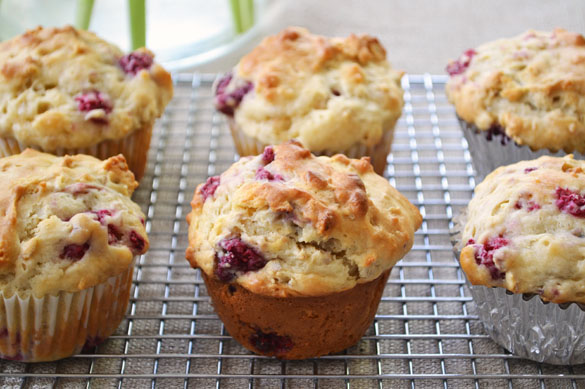
Baked Goods Featuring Raspberries Without Bleed and Full Coverage
01 October 2019Raspberries from whole to crumbles add rich flavor, vibrant color and nutrition to baked items.
By Washington Red Raspberry Commission
 Consumers love raspberries. Research shows nearly two-thirds of consumers personally like raspberries or raspberry flavor, and more than 75 percent of consumers wish they could find more food and beverage items made with raspberries. Nearly half of consumers describe raspberries as nutritious/healthy.
Consumers love raspberries. Research shows nearly two-thirds of consumers personally like raspberries or raspberry flavor, and more than 75 percent of consumers wish they could find more food and beverage items made with raspberries. Nearly half of consumers describe raspberries as nutritious/healthy.
Then why don’t people find more baked goods featuring raspberries? It could be that bleed and achieving equal coverage are challenging. However, if chef instructors know what format of fruit to request, they can beat some of these obstacles.
U.S. frozen raspberries, which are predominantly grown in Washington state because of its unique climate and soil, are picked at the peak of ripeness, and they are frozen within hours of being picked, locking in that peak flavor and nutritional value. Frozen raspberries are processed into a variety of formats, from whole to concentrate, in order to ensure no part of the berry is wasted and provide formats that work in a variety of products.
(Click here to read the Gold Medal Classroom’s Meet the Growers article on raspberries from Washington state.)
Individually Quick Frozen (IQF) whole raspberries are the ideal choice when berry identification is important to a dish, while IQF whole and broken raspberries, also called crumbles, puree, or juice concentrate are available when berry identification is not as important. Dehydrated powder and fragments can also be made from frozen formats and added as a dry ingredient or used for natural color and flavor. Each format plays an important role depending on the dish.
“Having access to a lineup of diverse products is important,” said Zak Miller, baking and pastry arts instructor at the New Orleans Culinary and Hospitality Institute (NOCHI). “As an educator, we cover so many different applications and raspberries are so versatile.
“There’s been a movement away from things that are so sweet, and the no sugar added, easily accessible and lower cost, frozen raspberry crumbles are meeting the demands of the market and setting trends with their acidity and floral attributes,” continued Miller.
IQF whole and broken raspberries are available to chefs and the ingredient market. The use of these smaller pieces reduces waste and produces a baked good with better coverage and less bleed.
“I think it’s extremely important to reduce food waste to us and to our guests. It’s come to the forefront of our field, not just from a financial standpoint but also from an environmental and social responsibility standpoint,” said Miller. “Also, you can use these formats on the culinary, pastry and bar side of the houses. This practice of sharing resources and even techniques with a high-quality ingredient saves money and space, which is really important in small restaurants and even hotels.”
Miller notes that it’s less important to use a whole berry in baking because it will break down anyway. Leaving them frozen until you are ready to add them into the batter helps maintain their integrity. Available at a lower cost typically than whole, IQF whole and broken work well in recipes for filling or sauces for baking.
“Having something like raspberries, a high-quality product with a flavor that is not too sweet, brings balance to whatever you’re making. Fruit in general but especially berries are so versatile too; they go with a lot of different products and have so many applications.”
Click here to download a PDF that features raspberries innovatively partnered with smoky, piquant, sweet, and umami flavors that single out the fruit’s flavor, aroma, brightness, and color.
Learn more about frozen red raspberries at redrazz.org.
Photos courtesy of Washington Red Raspberry Commission
